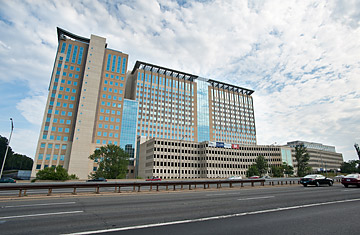
The Mark Center, the new office complex of the Department of Defense, in Alexandria, Va.
The truck bomb set off at the Alfred P. Murrah Federal Building in Oklahoma City in April 1995 vaporized one-third of the first and second floors, causing the seven floors above to collapse into the horseshoe-shaped vacuum that formed below. To achieve that horrific level of damage, Timothy McVeigh had simply driven up in a 24-ft. Ryder truck packed with 5,000 lb. of explosives and parked it in a loading lane on the north side of the building. The explosion killed 168 people and wounded nearly 700.
More than 16 years later, some Pentagon antiterrorism officials are increasingly anxious that something similar could take place at the Mark Center, a massive new Defense Department office complex that opens in September. The Mark Center is a shiny new two-tower facility located 3 miles south of the Pentagon. Constructed as part of the Base Realignment and Closure program to consolidate military bases and other facilities, the massive concrete-and-glass towers, 15 and 17 stories high, are the new home to 6,400 Pentagon staff with the department's Washington Headquarters Service, a hub of bureaucrats who perform Pentagon accounting, acquisition and other like-minded tasks. Workers have already begun trickling in to the complex, which is situated just a couple hundred feet away from Interstate 395, a six-lane highway that arcs southwest from the Pentagon into northern Virginia.
While there are a few guards wandering about at the Mark Center, many officials are concerned over the relative lack of security at the facility. Fueling that concern is an internal Pentagon blast study of the impact of a truck bomb on the Mark Center, a copy of which TIME has obtained. The study was conducted, using a series of plausible scenarios given the layout of the facility, because vehicles can drive right up unimpeded from a number of angles.
The studies explore the hypothetical impact of truck bombs ranging from 1,000 lb. to 20,000 lb. parked at various easily accessible Mark Center locations. Officials chose the bomb sizes to match the explosive punch of bombs used in various high-profile terrorist attacks, including Oklahoma City, Beirut in 1983, Khobar Towers in 1996 and Nairobi in 1998, among others.
Several of the studies show the Mark Center would essentially be wiped out. Some scenarios show almost the entire 6,400-worker facility bathed in red, indicating areas with: "Many serious injuries and many fatalities in outer offices. Wall and window debris in these areas will be thrown toward interiors and will cause moderate to severe injuries with potential fatalities in inner offices."
Given the site's current vulnerabilities, some Pentagon officials are befuddled as to why the Defense Department decided on that location, and why it has been left so unprotected. One antiterrorism official said he chose to speak with TIME reluctantly, only after internal warnings had been met with stony silence at the Pentagon. "I could not live with myself," if something happened at the Mark Center, the official said. He said of al-Qaeda: "These people are not stupid."
In April, the Project on Government Oversight (POGO) warned in a private letter to then Defense Secretary Robert Gates about the Mark Center, noting that a truck bomb "could easily be detonated in close proximity to the proposed new building, killing hundreds to thousands of DOD and contractor support employees." The Pentagon has not responded to the letter. DOD officials in the office of Secretary of Defense Leon Panetta and the Washington Headquarters Service did not respond to requests for comment from TIME either. Reuters reported an embarrassing story in April showing that the only blast analysis that had been conducted at that time for the Mark Center was for a 220-lb. bomb, a notably small payload, according to antiterrorism officials.
"The protection levels have been carefully reviewed by the authorities having jurisdictions and are in accordance with the same levels of protection currently in place at the Pentagon," said Ken Wells, a spokesman at the Army Corps of Engineers. "Because of the sensitivity of the information in question, USACE will not discuss specifics regarding force protection for (the Mark Center) because it could pose a potential threat to DoD personnel and the communities at large."
"I think it is shocking as hell," POGO's Peter Stockton said about the blast studies after TIME shared them with him. "Depending on the size of the bomb and the location of the detonation, the whole building could be brought down."
The vulnerability of the Mark Center is particularly striking because in the years after Oklahoma and 9/11, the federal government has made great efforts to harden government buildings to truck bombs, the weapon of choice for domestic and international terrorists alike. In 2007, in fact, the Defense Department issued guidelines for buildings directing that, "The primary design strategy is to keep terrorists as far away from inhabited DOD buildings as possible." In that spirit, the department recently spent more than $30 million to dig up 4,000 ft. of one of the roads adjacent to the Pentagon, Route 110, and move the highway several hundred yards east away from the building. Likewise, the National Naval Medical Center in Bethesda, Md., was recently expanded to incorporate Walter Reed Army Medical Center. Security there remains tight, with high fences and security checkpoints hundreds of yards from the nearest hospital buildings. At the Mark Center, meanwhile, there are guarded (albeit minimal-looking) gates, but they are surprisingly close to the buildings themselves, in some cases just feet away.
